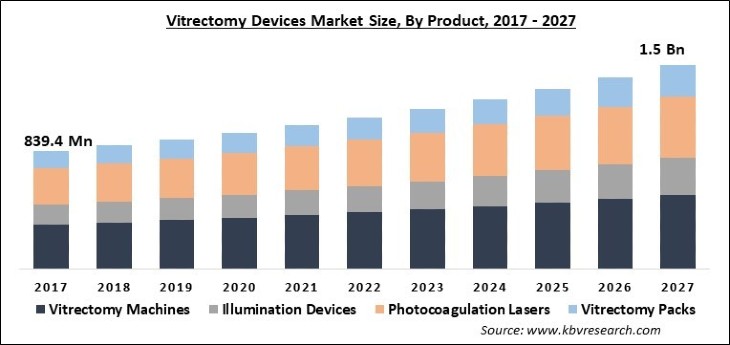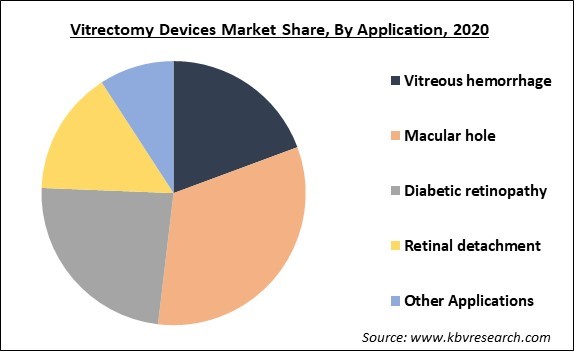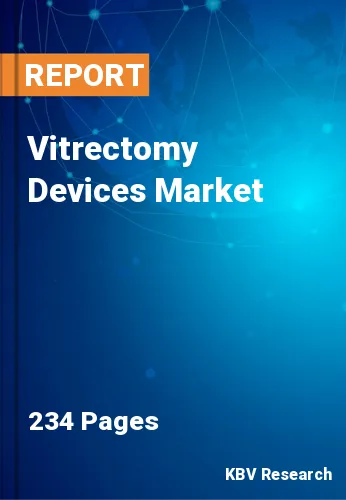The Global Vitrectomy Devices Market size is expected to reach $1.5 billion by 2027, rising at a market growth of 6% CAGR during the forecast period. Vitrectomy refers to a surgical procedure utilized to eliminate vitreous gel from the eye. It is performed when there is retinal detachment with vitreous hemorrhage. Additionally, it is utilized for several repairs like the removal of scar tissue and treating small holes or tear in the macula. Vitrectomy assists in removing vitreous humor from the blood and in preventing retinal traction detachment. As a result, this streamlines the procedure of other ophthalmic surgeries and prevents further detachment of the retina throughout the same. In addition, vitrectomy also assists in restoring vision loss occurred because of bleeding of the vitreous humor.
The growing geriatric population and technological developments in surgical equipment are expected to act as catalysts for the growth and demand for vitrectomy devices in the market. Moreover, factors such as increasing awareness about cost-effective surgical procedures among the common population and usage of minimally invasive surgical equipment would create lucrative growth opportunities for the players operating in the vitrectomy devices market. Conversely, the growth of the vitrectomy devices market would be hampered by the less availability of effective healthcare services and sluggish penetration of healthcare technology in various emerging countries.
The growth of the market is further fueled by the increase in the occurrence of diabetes, which would further increase the probability of diabetic retinopathy. In addition, the vitrectomy market is expected to witness bright growth prospects due to the rising demand for vitrectomy because of its related benefits for offering support to other ophthalmic surgeries.

A majority of medical practices including ophthalmology has been adversely impacted by the global pandemic. It has been witnessed that approximately 1% to 3% of people with COVID-19 infection develop conjunctivitis. Therefore, to minimize human contact and curb the spread of coronavirus, ophthalmologists were encouraged not to perform ophthalmic surgeries throughout the pandemic except for emergency care. Several end-users in various regions are witnessing a reduction in ophthalmic surgeries like vitrectomy. Though, the government is undertaking many initiatives and is formulating guidelines to streamline medical care including ophthalmic surgeries such as vitrectomy throughout the pandemic. These factors are anticipated to support the market growth during the forecasting period.
The increase in the occurrence of diabetic retinopathy and retinal detachment (RD) is directly boosting the demand for vitreoretinal surgery devices. A huge population base is suffering from diabetic retinopathy and eye disorders that have increased the awareness among the individuals regarding these conditions and other associated diseases.
Vitrectomy cleans the blood from vitreous humor that cannot be cleansed by the eye itself. The surgery avoids traction retinal detachment and assists in preventing further or subsequent detachment. In addition, it can also restore vision loss that occurred during bleeding of the vitreous humor. It treats and repairs massive tears in the retina and prevents scar tissues to develop new blood vessels. In addition, constant technological advancements such as convenience in the utilization of vitreoretinal surgery devices and automation are expected to increase sales and adoption of vitrectomy devices in the market.
Many emerging countries like India, Kenya, Saudi Arabia, South Africa, and Israel are witnessing a massive rural population and people belonging to this group have less or no knowledge and awareness about eye diseases. These economies are also witnessing declined or restricted access to sophisticated eye care. Scarcity and low availability of primary eye care are major factors boosting the rate of blindness. Moreover, the situation is further deteriorated by the absence of awareness and low access to quality eye care products in such countries.

Based on Application, the market is segmented into Vitreous hemorrhage, Macular hole, Diabetic retinopathy, Retinal detachment, and Other Applications. The retinal detachment segment would display the fastest growth rate during the forecasting years. Additionally, retinal detachment is highly observed in patients having high myopia. The segment growth is fueled by the increase in the occurrence of high myopia around the world.
Based on Product, the market is segmented into Vitrectomy Machines, Illumination Devices, Photocoagulation Lasers and Vitrectomy Packs. The vitrectomy machines segment obtained the maximum revenue share of the vitrectomy devices market in 2020. Factor such as the development of world-class machines with sophisticated features like high cut rates, improvised fluidics, intraocular pressure control, and small gauge size is responsible for the growth of this segment. For example, the Constellation Vision System of Alcon has fluidics that is suitable for small-gauge surgery, hence addressing the limitations of earlier machines.
Based on End Use, the market is segmented into Ophthalmology clinics, Hospitals and Ambulatory Surgical Centers. The hospital segment obtained the largest revenue share of the vitrectomy devices market in 2020. This is attributed to the surge in the adoption rate of vitrectomy surgeries in these settings. Numerous hospitals are providing ophthalmic care including vitrectomy, which would fuel the deployment of vitrectomy devices in these hospitals.
| Report Attribute | Details |
|---|---|
| Market size value in 2020 | USD 974.2 Million |
| Market size forecast in 2027 | USD 1.5 Billion |
| Base Year | 2020 |
| Historical Period | 2017 to 2019 |
| Forecast Period | 2021 to 2027 |
| Revenue Growth Rate | CAGR of 6% from 2021 to 2027 |
| Number of Pages | 234 |
| Number of Tables | 385 |
| Report coverage | Market Trends, Revenue Estimation and Forecast, Segmentation Analysis, Regional and Country Breakdown, Competitive Landscape, Companies Strategic Developments, Company Profiling |
| Segments covered | Application, Product, End Use, Region |
| Country scope | US, Canada, Mexico, Germany, UK, France, Russia, Spain, Italy, China, Japan, India, South Korea, Singapore, Malaysia, Brazil, Argentina, UAE, Saudi Arabia, South Africa, Nigeria |
| Growth Drivers |
|
| Restraints |
|
Based on Regions, the market is segmented into North America, Europe, Asia Pacific, and Latin America, Middle East & Africa. Europe region is expected to witness a promising growth rate during the forecast period. Factors such as the increasing occurrence of eye disease, rise in R&D investments for the development of innovative products, and rising demand for technologically upgraded products are expected to unlock growth prospects for the regional vitrectomy devices market. Carl Zeiss Meditec, a company based in Germany in the ophthalmic devices market, is putting efforts towards R&D activities to provide advanced products in the European as well as global market.
Free Valuable Insights: Global Vitrectomy Devices Market size to reach USD 1.5 Billion by 2027

The major strategies followed by the market participants are Product Launches. Based on the Analysis presented in the Cardinal matrix; Johnson & Johnson is the major forerunners in the Vitrectomy Devices Market. Companies such as Bausch Health Companies, Inc., Nidek Co., Ltd., Carl Zeiss AG are some of the key innovators in the market.
The market research report covers the analysis of key stake holders of the market. Key companies profiled in the report include Bausch Health Companies, Inc., Carl Zeiss AG, Johnson & Johnson, Topcon Corporation, Hoya Corporation, Alcon, Inc., Beaver-Visitec International, Inc. (TPG Capital), Blink Medical Ltd. (Katena Products, Inc.), Nidek Co., Ltd., and Lumenis Ltd.
By Application
By Product
By End Use
By Geography
The global vitrectomy devices market size is expected to reach $1.5 billion by 2027.
High occurrence of retinal disorders are driving the market in coming years, however, low amount of awareness and less access to eye care in under-developed countries have limited the growth of the market.
Bausch Health Companies, Inc., Carl Zeiss AG, Johnson & Johnson, Topcon Corporation, Hoya Corporation, Alcon, Inc., Beaver-Visitec International, Inc. (TPG Capital), Blink Medical Ltd. (Katena Products, Inc.), Nidek Co., Ltd., and Lumenis Ltd.
The macular hole segment procured the highest revenue share of the vitrectomy devices market in 2020. Moreover, the segment would showcase a prominent growth rate during the forecasting period.
The vitrectomy packs segment would exhibit the fastest growth rate during the forecast period. This is owing to the higher adoption rate of these packs in various indications like removal of vitreous from retina, collective procedures for retinal surgery, removal of epiretinal membrane, and detachment of posterior vitreous.
In 2020, North America emerged as the leading region by obtaining the maximum revenue share in the vitrectomy devices market.
Our team of dedicated experts can provide you with attractive expansion opportunities for your business.

